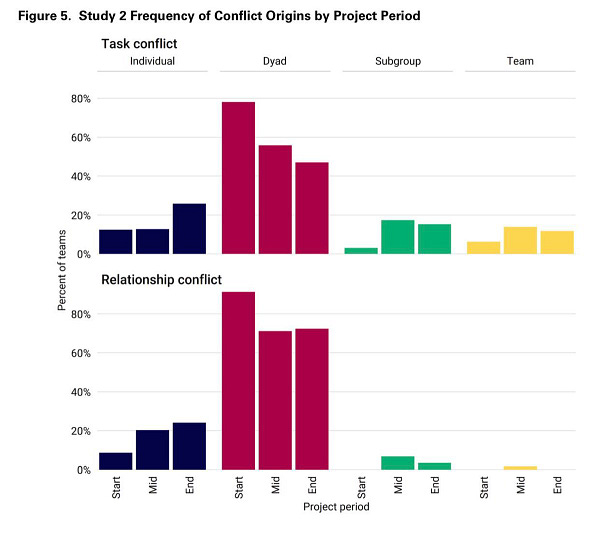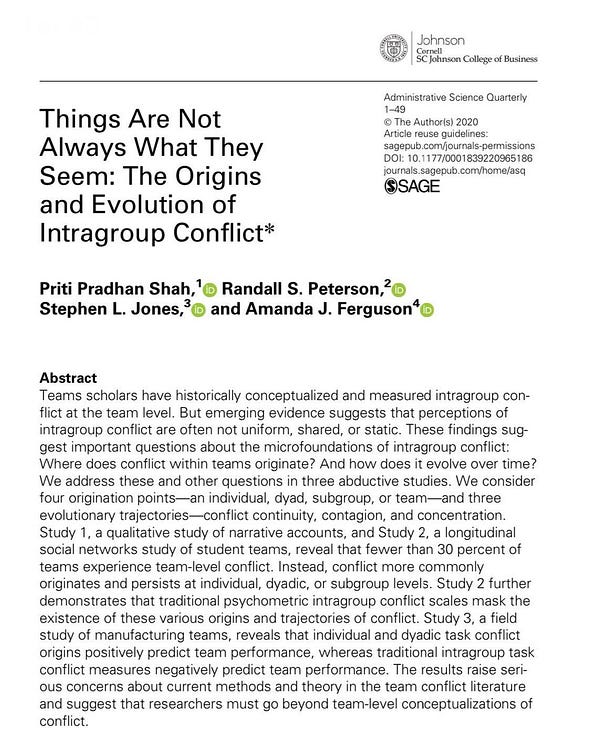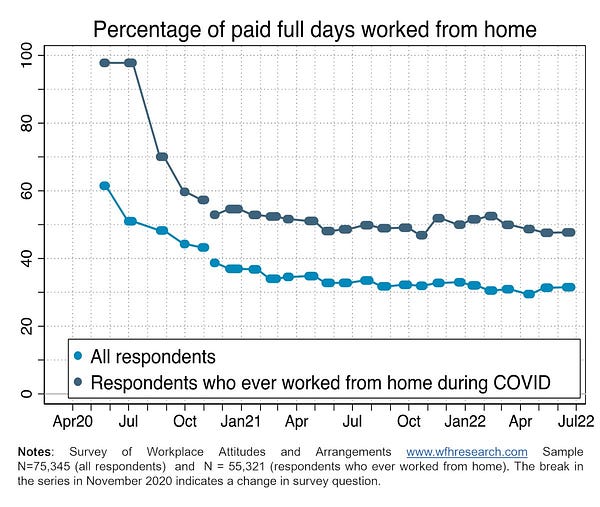Perspective on Risk - Feb 8, 2023 (Management Issue)
CEOs; Getting Projects Done; People; Discrimination; Drowning in Bullshit; I Would Never; Why Should Friday Be Different?; Productivity & Compensation; Culture
The most-forwarded posts I wrote last year were the “management” issues, so I thought I would write another one. None of you will likely implement any of this, and that makes me sad.
Much of this post comes from the Twitter feed of Wharton Prof. Ethan Mollick. He is also the author of one of my favorite substacks One Useful Thing that I’ve frequently referenced in the past. You should subscribe to his stuff and follow him on Twitter.
CEOs
… May Be More Effective In Their First Years
From The “CEO in context” technique revisited: A replication and extension of Hambrick and Quigley (2014)
Controlling for the number of variables used in the estimations, the model attributes about a third of the total variance of firm performance (ROA) to the CEO. Further analyses show that the model findings differ for firms of different size and CEO tenure; the larger the firms and the longer the CEO tenures, the smaller tends to be the percentage of variance explained by the CEO.


… Shirk If Not Monitored



Bosses Use Social Media More Than Their Staff
In Predictors of Use of Social Network Sites at Work - A Specific Type of Cyberloafing the authors show
that managers and executives, while critical of employees’ social media use at work, spend more time using social media during office hours than do their subordinates.
Men are also more likely than women to browse the Internet during work hours.
Getting Projects Done
Project Timelines Fail To Anticipate Interdependencies
Entrepreneurial learning and strategic foresight studied 722 projects and found that “entrepreneurs make less accurate predictions as they gain experience executing projects.” But the interesting observation is why:
we argue that entrepreneurs also learn of opportunities to augment each successive product, which drastically expands the interdependencies beyond what an entrepreneur can anticipate. We find that entrepreneurs encounter more unforeseen interdependencies in their subsequent projects, and they sacrifice on-time delivery to address these interdependencies.
[W]e propose three ways a manager can make more accurate timeline predictions for firm strategy.
First, we see an opportunity for firms to make an intentional effort to better anticipate the nonlinear nature of complexity by accounting for the faster-than-linear increase in unforeseen interdependencies when building out projects.
Second, firms can learn to make more accurate timeline predictions by internalizing salient experiences with interdependencies.
Third, future research should explore whether firms can improve timeline predictions in complex situations by increasing their knowledge diversity . A more diverse knowledge base increases the breadth of interdependencies a firm will be aware of when making predictions. An increased breadth of awareness should lead to improved foresight
On Time & On Budget
A study of some 16,000 major projects—from large buildings to bridges, dams, power stations, rockets, railroads, information technology systems, and even the Olympic Games—reveals a massive project-management problem. Only 8.5% of those projects were delivered on time and on budget, while a mere 0.5% were completed on time and on budget and produced the expected benefits. In other words, 99.5% of large projects failed to deliver as promised. Master architect Frank Gehry consistently defies those odds, producing projects of staggering beauty while meeting time and budget targets. This article reveals four lessons, gleaned from Gehry and his colleagues, for successfully managing big projects.
Make Sure You Have the Power to Deliver What You’re Accountable for
Always Ask “Why?”
Simulate, Iterate, Test
Think Slow, Act Fast
People
Managers Over-Emphasize Conflict Prevention
Those who have worked for me have probably heard me tell you at some point that I thought you were over-weighting team harmony in your decisions (such as raises and promotions).
Things Are Not Always What They Seem: The Origins and Evolution of Intragroup Conflict (LBS) examines conflict through a number of studies, findintg:
fewer than 30 percent of teams experience team-level conflict. Instead, conflict more commonly originates and persists at individual, dyadic, or subgroup levels.
traditional psychometric intragroup conflict scales mask the existence of these
various origins and trajectories of conflict.
individual and dyadic task conflict origins positively predict team performance, whereas traditional intragroup task conflict measures negatively predict team performance



Hiring
I’ve ranted before that all of the evidence that exists shows that most methods used to select people don’t work. Unstructured Job Interviews Are Worse Than No Interviews At All. Unstructured interviews are also discriminatory: Hiring For Cultural Fit Just Means Hiring Yourself. And some of the crap that is tried is just downright bad: Brain-teaser Interviews Are Ineffective & Sadistic
What Methods Work Best When Hiring?
Structured interviews (which we used effectively at the Federal Reserve, but did not use at AIG) are the most effective method. Other studies have found that unstructured interviews are horribly ineffective and lead to high levels of bias.
Job knowledge tests and/or work sample tests also are important.
Developing Structured Interviews
The first step is to make sure you have identified the critical skills required for the job. When at the Fed we divided these into “price of entry” skills and those that would “differentiate” a candidate.
Here is a useful guide: it has a list of about 60 skills along with sample interview questions. The first step is to get agreement on what the price of entry and differentiating skills are most important. I’d recommend having no more than four price of entry skills and two differentiating skills. Once you have these, select the questions each interviewer will ask - they will ask each candidate the same exact questions, and evaluate their responses.
For instance, for a manager perhaps Developing Others is a differentiating skill. The guide describes this skill as:
Creates an environment that fosters learning, growth, and development. Provides challenging tasks and assignments that encourage continuous development of team members. Encourages direct reports to accept development moves. Is aware of each team members’ strengths, development needs and career goals. Participates in frequent development and coaching discussions. With employee, constructs targeted development plans and executes them.
And some sample questions are:
Describe the number one development needs of one of your direct reports. What was the development? What did you do to coach him/her to develop in this area? What improvements have taken place?
What written development plans are in place for your employees? What do they look like?
How often do you have development discussions with your employees? Describe the last development discussion you had with an employee. How did you prepare? What could you have done differently and why?
You do not want to let the candidate answer in generalities - that is often used to mask the lack of the skill - push for a specific example in each case.
Job Descriptions
Having gone through the critical skills exercise, you will be well positioned to craft a prioritized job description. Avoid adding non-critical requirements. And use ChatGPT to help write the description.
Knowledge Tests
Knowledge tests are also very useful. You should try and have these done in writing, rather than verbally, so that the responses can be appropriately compared against one another.
ChatGPT can be an extremely useful tool in helping you craft these questions. For instance, in this thread I ask ChatGPT to develop three questions each for:
a junior financial analyst working in the capital management unit of a banking firm;
junior analyst on the economic capital modeling team;
the manager of the capital management unit;
the Comptroller.
Andrew Wilkinson’s Anti-Goals


Praise, Praise, Praise





Turnover
Surveying the forest: A meta-analysis, moderator investigation, and future-oriented discussion of the antecedents of voluntary employee turnover provides a nice, thorough overview of the factors that affect employee turnover.
The relationship between pay and turnover has increased since … (2000), suggesting that the influence of pay on exit decisions is perhaps stronger today than it was two decades ago.
Many other predictors more readily controlled by managers can be more important than pay
A prevailing thought many managers hold about turnover is that it is mostly due to dissatisfaction with the work itself or low pay, and because “the job is the job,” rarely can anything be done to remedy high quit rates (or, they simply accept them as bearable).
To the contrary, our results corroborate the notion that often, “employees quit bosses, not jobs,” and that at least as much, turnover can be due to toxic work climates or feeling unsupported by the organization.
Discrimination Against Women and the “Potential” Excuse
Women Aren’t Promoted Because Managers Underestimate Their Potential (Yale)
In a study of evaluation and promotion data from a large retail chain, Prof. Kelly Shue and her co-authors found that women got higher performance ratings than men but were consistently—and incorrectly—judged as having less leadership potential.
Shue and her colleagues found that while women receive higher performance ratings—they are 7.3% more likely than men to receive a “high” rating in performance—their potential ratings are 5.8% lower. The authors estimate that lower potential ratings explain up to 50% of the gap in promotions.
Read the study:
Drowning in Bullshit
Many organizations are drowning in a flood of corporate bullshit, and this is particularly true of organizations in trouble, whose managers tend to make up stuff on the fly and with little regard for future consequences.
Confronting Indifference Toward Truth: Dealing With Workplace Bullshit
We define workplace bullshit as taking place when colleagues make statements at work with no regard for the truth. The term bullshit therefore comprises both the communicative act and the information in it. Bullshit can be conveyed in written form (e.g., emails, letters, reports), spoken form (e.g., conversations, speeches, audio/video recordings), and graphical form (e.g., photographs, charts, diagrams).
The disregard-for-the-truth aspect of the definition underlies how bullshit is a form of misrepresentation that differs from lying. A liar is someone who is interested in the truth, knows it, and deliberately misrepresents it. In contrast, a bullshitter has no concern for the truth and does not know or care what is true or is not.
We then introduce a four-step framework for understanding how to deal with workplace bullshit:
Comprehend workplace bullshit;
Recognize workplace bullshit;
Act against workplace bullshit; and
Prevent workplace bullshit from occurring.
So in addition to the “no jerks” principle, perhaps you want to add a “no bullshit” mantra.
Actually, this sounds like a fun job; I’m available if anyone wants to hire me to call out the bullshit in your organization.



I Would Never Do This To You



Why Should Friday Be Different From Any Other Day?

Seriously. From a business perspective why should Friday be different from Tuesday? If the work can be done from home, it can be done from home. If not, it can’t. If a team needs to meet for ideation, etc. then schedule a day for folks to all be in.
Nobody wants to be in the office on Fridays Bhattarai, Washington Post
Just 30 percent of office workers swiped into work on Fridays in June, the least of any weekday, according to Kastle Systems, which provides building security services for 2,600 buildings nationwide. That’s compared to 41 percent on Mondays, the day with the second-lowest turnout, and 50 percent on Tuesdays, when the biggest share of workers are in the office.
The 3-Day Return to Office Is, So Far, a Dud
In New York, only 8 percent of workers are in the office five days a week, according to the latest survey from the Partnership for New York City. Seventy-eight percent of workplaces have adopted a hybrid model, compared to 6 percent before the pandemic. “It’s a complete turnabout. It’s quite revolutionary,” Kathryn Wylde, the Partnership’s president, told the New York Times. “The employers have come kicking and screaming to this position. They’re not thrilled.” At the moment, 38 percent of New York office workers are at their desks on any given weekday, a number that’s expected to creep up to 49 percent after Labor Day, according to the Partnership. But we’ve all heard overoptimistic return predictions before.
Don't use the office as a crutch.
The Office Is Killing You (Ramp Capital)
As the CEO of Zillow recently put it, people are now "wrapping your work around your life instead of vice versa. It’s not sitting in hours of traffic for a daily commute. It’s being able to pick up your kids from school without anyone looking askance at what time you leave the office. It’s having your performance judged by the outcomes you achieve, not your ability to sit in a certain chair from 9 to 5."
For employers currently facing the decision to ask employees to RTO, the very first question they should ask themselves is are you hitting your goals and objectives? If yes, then why risk alienating a competent and functioning team if they do not wish to RTO? If your team is not hitting your goals and objectives, then you need to determine the source of underperformance and if working in an office setting will actually fix the issue. Don't use the office as a crutch. Use real evidence and data instead.
Personally, I don’t think I can ever go back to a corporate office setting unless it's restructured from what it used to be. I'd be fine if it was in a smaller, intimate group setting where we could actually get real work and collaboration done. But going in to the office to sit on Zoom meetings all day and sit in front of a computer is just checking the box.


Digital By Design
I was perusing Shopify’s site, and came across this in their recruiting literature:
I’ve copied the text here in case you can’t read it:
Office centricity is over. We are digital-first. That means you do your daily work wherever you work best, so we hire you where you are. Most of us then gather in real life several times a year to connect, solve hard problems, and align as a team. We call this way of working Digital by Design, or DxD.
Listed below are the core countries we hire in (although we’ll hire anywhere if you’re exceptional).
They get it, do you?
The Fully Customized Office
Julia wrote the book Work and Life and has a podcast called The Nowhere Office. Here is the thread referenced above.
[I]f Fully Remote only works for some but not all and a one-size fits all Fully Hybrid is proving inadequate, what will work? We're now in phase 3 of The Nowhere Office: "Fully Customised" in which not having a one size fits all standard is becoming the smart way to manage.
Fully Customised means that you take your team and your work and your workplace and regard it as a unique family of group which has its own unique needs for any given period of time and industry and create a way of working accordingly. It is a huge shift from standardisation


Worker Productivity, Compensation and Toxic Workers
Ethan Mollick linked to an interesting NBER post: Concentration of High-Tech Workers Has Benefits — and Costs. Most of the time, location decisions seem to come down to 1) cost and 2) desire to consolidate staff to generate ‘company synergies.’
Now this last point has been challenged by Covid and the WFH movement. So Mollick rightly rephrases the cost question to a cost vs. productivity question.
Now, the NBER posits:
Productivity increases at a steady rate as clusters of scientists and engineers grow larger, but associated R&D costs rise more rapidly at higher levels of agglomeration.
So… they conclude:
Productivity increases at a steady rate as clusters of R&D workers become more concentrated; however, R&D costs rise more rapidly at higher levels of agglomeration. This means that increased productivity delivers diminishing net returns to the firms carrying out this research.
Mollick, however, points out that at the highest level of agglomeration, in the costliest cities, the productivity gains (more than) make up for the cost!









